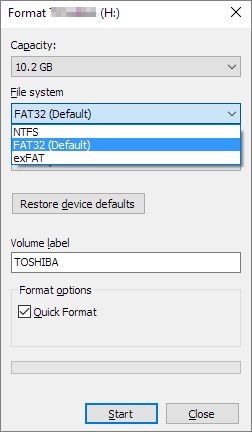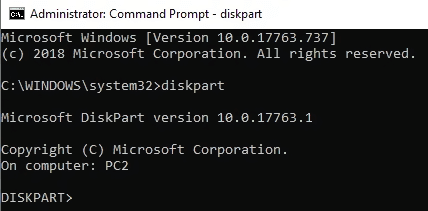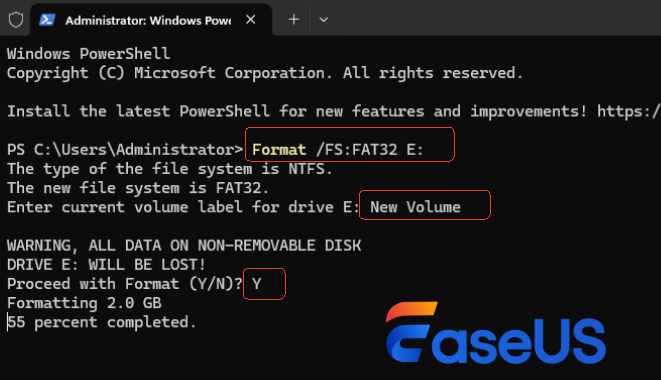Featured Articles
- 01 What Is NTFS File System
- 02 What Is exFAT Format
- 03 What Is FAT File System Format (FAT, FAT16, FAT32)
- 04 What Is EXT2/3/4 File System (Linux) Format
- 05 NTFS VS exFAT VS FAT32, What's the Difference
- 06 How to Change File System to NTFS, FAT32, EXT
- 07 How to Convert File System - NTFS to FAT32
- 08 Best FAT32 Converter Free Download
- 09 Troubleshoot File System Errors
- 10 Fix File Is Too Large for Destination File System
- 11 Fix Volume Does Not Contain A Recognized File System
Real case from Reddit: How do I convert NTFS to FAT32 USB for free? - From r/techsupport
Real case from Reddit: How to change ntfs partition to FAT32 without formatting or losing data - From r/linus4noobs
If you are looking for a free way to convert NTFSto FAT32 without any data loss or cost, this page is the right place for you. This page outlines five methods for converting from NTFS to FAT32. EaseUS Partition Master is a reliable NTFS to FAT32 converter, which allows you to convert NTFS to FAT32 without losing data. It supports USB flash drives, SSDs, HDDs, external hard drives, SD cards, and more. Unlike Windows' built-in tools, it breaks the limit and supports converting a partition larger than 32GB to FAT32.
NTFS and FAT32 are two system file types used in the Windows operating system. Before the conversion, be aware that the FAT32 file system has a 4GB limit on the size of individual files, which will prevent you from storing files larger than that on a FAT32 drive.
In the following, you'll learn the differences between NTFS and FAT32, when to use NTFS or FAT32, and how to convert NTFS to FAT32 without losing data with 5 reliable NTFS to FAT32 converter tools:
- Method 1. EaseUS Partition Master Free (Recommended)
- Method 2. Using Windows File Explorer
- Method 3. Using Disk Management
- Method 4. Convert NTFS to FAT32 with Command Prompt
- Method 5. Convert NTFS to FAT32 via PowerShell
Note: For a straightforward NTFS to FAT32 converter, take Method 1 for help. Methods 2, 3, 4 , and 5 will cause data loss while converting NTFS to FAT32. So make sure that you back up essential content to another secure device in advance.
So, how to change the file system from NTFS to FAT32? Try any method below and you'll learn how to finish this task on your own.
How to Convert NTFS to FAT32? 5 Efficient Ways
In the following, we'll cover 5 reliable NTFS to FAT32 converter tools that will help you effectively convert NTFS to FAT32 with ease. Before we get started, make sure you know the following information:
- All 5 NTFS to FAT32 converters support all Windows OS, including Windows 11/10/8/7/XP/Vista, etc.
- The earlier the method is presented, the easier it is for you to change the file system of your device.
- Support converting USB flash drives, SD cards, and external hard drives from NTFS to FAT32.
- Back up your data before you make any changes to your disk drive.
Method 1. Free NTFS to FAT32 Converter
- 🚩Cost: Free
- ⚒️Data Loss: No
- 🚫Capacity Limit: No, support converting large (over 32GB) to FAT32
The easiest way is to use a free third-party NTFS to FAT32 converter software. EaseUS Partition Master Free with its "Convert to FAT" feature, can help you do this job easily. It is a free tool that allows you to change the file system between NTFS and FAT32. This method won't require you to format the target device while converting NTFS to FAT32, and no data will be lost.
Here are the steps:
Step 1. Open EaseUS Partition Master, navigate to "Partition Manager," right-click target NTFS partition and select "Format."
Step 2. Click and change the File System from NTFS to FAT32.
Step 3. Click "OK" and the warning message will prompt, click "Yes" to confirm.
Step 4. Select "Execute 1 disk" and "Apply" to keep all the changes.
The powerful software works perfectly in Windows 11, 10, 8, 8.1, 7, XP, and Vista. It does more than simply format NTFS devices to FAT32. It also supports the following:
- Support other file systems, including exFAT, FAT16, Ext2/3/4, etc.
- NTFS to exFAT converter without data loss, Convert FAT32 to NTFS without formatting.
- Supports formatting 64GB/128GB UBS to FAT32 without limit.
- Supports advanced features, including resizing partitions, converting a disk to MBR/GPT, transferring OS, etc.
- Important
- Aside from Method 1, Methods 2,3 4, and 5 all require formatting a device to accomplish converting NTFS device to FAT32. So, ensure that you back up the important data to a secure location in advance.
- You can use free backup software to back up important data.
Method 2. Using Windows File Explorer
- 🚩Cost: Free
- ⚒️Data Loss: Yes, format the target partition during the process
- 🚫Capacity Limit: No, support converting large (over 32GB) to FAT32
As for most Windows users, another easy way to try to change NTFS to FAT32 is using Windows' built-in FAT32 formatter - Windows File Explorer.
🚩Data Loss Warning: Note that this will format your device, so make sure you have backed up essentials on your drive before moving to the steps below.
The process is efficient and easy. Let's see the step-by-step guide on how to use File Explorer:
Step 1. Connect your hard drive or external storage device to a Windows PC.
Step 2. Double-click This PC/My Computer to open File Explorer.
Step 3. Locate and right-click on the USB drive and select "Format".
Step 4. Set the FAT32 as the target file system, tick "Quick Format", and click "Start" to start the formatting.

When you finish the formatting, click "OK" to confirm. Now, your device is with FAT32.
Method 3. Using Disk Management
- 🚩Cost: Free
- ⚒️Data Loss: Yes, format the target partition during the process
- 🚫Capacity Limit: The target partition should be 32GB or smaller
The other method is to use Disk Management. Note that the FAT32 option will be unavailable in the drop-down box if the drive size you desire to format is larger than 32GB (Windows limitation).
🚩Data Loss Warning: The procedure will also convert NTFS to FAT32 by formatting, so back up data before your operations.
How can I convert the USB Drive format from NTFS to FAT32?
1. Right-click "This PC" or "My Computer", click "Manage", and click "Disk Management".
2. Choose your USB Drive, right-click the drive, and choose "Format". Click "Yes".

3. Name the drive and select the file system as "FAT32". Click "OK".
4. You can find the format is FAT32.
When the formatting completes, you can find the format is FAT32 displayed in Disk Management.
Method 4. Convert NTFS to FAT32 with Command Prompt
- 🚩Cost: Free
- ⚒️Data Loss: Yes, format the target partition during the process
- 🚫Capacity Limit: The target partition should be 32GB or smaller
Unlike Windows File Explorer and Disk Management, Command Prompt does more than merely format devices. It also performs advanced management tasks on Windows and Windows Server machines. Connect the storage device that you need to convert from NTFS to FAT32 to your PC and follow the steps to begin:
🚩 Warning: Diskpart will erase all your data on the target partition or device, so make sure you have a copy of your data in advance. Also, for beginners, Diskpart might be a little difficult so you need to be very careful with the following steps.
To use the DiskPart command line to change the file system to FAT32, follow the steps below:
Step 1. Type cmd in Windows Search, right-click on Command Prompt, and select "Run as administrator".
Step 2. Type diskpart into the Command Prompt window and hit Enter.

Step 3. Type the following command lines and hit Enter each time:
- list disk
- select disk 0(Replace 0 with the disk number of your target device)
- list volume
- select volume 2(Replace 2 with the volume number of your device)
- format fs=fat32 quick
Step 4. When the formatting process is complete, type exit to close DiskPart.
After this, your device is now with FAT32.
Method 5. Convert NTFS to FAT32 via PowerShell
- 🔢Difficulty Level: Hard
- ⏱️Duration: 2-4 minutes
- 🧑🏻💻Best for: Experienced/advanced users, administrators
- 🚫Capacity Limit: Device should be 32GB or smaller
PowerShell can also help you convert NTFS to FAT32 by formatting, so it will cause data loss during the process. Also, it requires you to enter command lines to perform NTFS to FAT32 conversion. To guarantee a smooth conversion, make sure you follow the instructions below carefully.
Notice: Back up your data in advance before you make any changes to your disk.
Step 1. Press "Windows" + "X" and select "Windows PowerShell Admin". (On Windows 11, please select "Terminal Admin."
Step 2. Once you're in the command-line interface, simply type the following command and press Enter to confirm.
format /FS: FAT32 E: (Again, make sure to replace "E" with the drive letter that you want to convert).
Step 3. Now, PowerShell will ask you to enter the current volume label for drive E. Here, I enter New Volume. (You can check the volume label in Disk Management.
Step 4. Confirm the conversion by entering Y.

NTFS vs. FAT32, Which Is Better
Is NTFS better than FAT32? FAT32 is one of the oldest file system variants of FAT, used in earlier versions of the operating system, such as DOS and Windows versions before XP. Till now, FAT32 is still serving Windows users as the default format for some external storage devices such as SD memory cards and USB flash drives.
NTFS is a newer file system developed by Microsoft after FAT. NTFS, known as NT File System, is the default file system of the Windows NT family, including the latest Windows operating system.
You can refer to this link of NTFS vs FAT32, or refer to the comparison table between NTFS and FAT32, and you can see more details between them:
| Features | NTFS | FAT32 |
|---|---|---|
| Maximum Volume Size |
|
32GB - 2TB |
| Maximum File Size | 16TB | 4GB |
Accordingly, FAT32 supports up to 4GB files and a 2TB max volume size. In other words, you can only save single files smaller than 4GB to a FAT32 device. NTFS supports up to 16TB single files with 2 - 4 TB volume size in practice. To be more strict, Windows has a file system limit on FAT32, and it only allows devices to use FAT32 on 32GB or smaller volume partitions.
When to Use NTFS or When to Use FAT32?
So, when should you use NTFS or FAT32? Here, we list some common usages of NTFS and FAT32 that can help you determine whether you need NTFS or FAT32:
| When to Use NTFS | When to Use FAT32 |
|---|---|
|
|
According to this table, FAT32 is obviously more widely used on external storage devices and file transfer.
So which is better? To store large files or create a large volume-sized partition, NTFS is obviously better than FAT32. Click the buttons to share this article and let more people know about this conclusion.
Bonus Tip: Convert NTFS to FAT32 on Mac
By default, Apple only allows users to access NTFS files on a Mac in read-only mode. But luckily, you can convert NTFS to FAT32 via formatting, which will erase all the contents of the hard disk.
Therefore, back up your important data before doing anything to the NTFS drive.
Here is how to convert NTFS to FAT32 so that the disk can be read and written normally on a Mac:
Step 1. Connect the NTFS Drive
Plug the NTFS external hard drive or USB into your Mac.
Step 2. Open Disk Utility
- Press Command + Space and type Disk Utility, then hit Enter.
- Or go to Applications > Utilities > Disk Utility.
Step 3. Select the NTFS Drive
In the left sidebar, choose the NTFS disk you want to convert.
Step 4. Erase the Drive
Click the Erase button at the top.
In the pop-up window:
- Name: Give the drive a name.
- Format: Choose MS-DOS (FAT) (this is FAT32).
- Scheme: Select Master Boot Record (MBR) for best compatibility.
Step 4. Confirm and Erase
Click Erase to begin formatting. The process will take a few moments. Once complete, the drive will be reformatted to FAT32. Now you can read and write to it on a Mac without limitations.
- Tip
- To convert NTFS to FAT32 on Mac without losing data, you can turn to EaseUS NTFS for Mac, which supports full read and write access to NTFS drives in macOS without formatting the original NTFS drive.
The Bottom Line
On this page, we explained what NTFS is, what FAT32 is, and when to use NTFS or FAT32. As FAT32 obtains higher compatibility, we also provided 5 NTFS to FAT32 conversion methods to help you change the file system of your device from NTFS to FAT32 with ease.
It doesn't matter if you are not quite sure about which method to select. Here is a list of EaseUS Editor's suggestions and you may take a view here to select the best one for help:
| NTFS to FAT32 Conversion Tools | Complex Level | Who to Use It |
|---|---|---|
| #1. Use EaseUS Partition Master Free | Easiest | Beginners |
| #2. Use Windows File Explorer | Easy | Beginners |
| #3. Use Disk Management | Medium | Experienced users |
| #4. Use DiskPart Command Prompt | Hard | Advanced users |
If you prefer an easy and effective FAT32 formatter, especially to format big devices (more than 32GB) to FAT32, EaseUS Partition Master is always ready to help.
FAQs about converting NTFS to FAT32
If you are having other doubts about converting NTFS to FAT32, follow and view the answers to the listed questions below.
1. Can I convert NTFS to FAT32?
Yes, to convert an NTFS drive to FAT32 on Windows, back up any important data, then open File Explorer, right-click the drive you want to convert, select "Format," choose FAT32 from the "File system" dropdown, and click "Start" to format the drive.
2. How to convert NTFS to FAT32 online?
You cannot convert NTFS to FAT32 online because the conversion process requires access to the drive's file system, which cannot be performed through a web browser for security reasons. You must use a local disk management tool, such as Windows' built-in Disk Management, to format the drive to FAT32, which will erase all data on the drive. Alternatively, use a third-party tool such as EaseUS Partition Master to convert NTFS to FAT32 without losing data.
3. How can I convert NTFS to FAT32 on Mac?
To convert a drive from NTFS to FAT32 on a Mac, you can use Disk Utility to erase and reformat the drive to MS-DOS (FAT) (which is FAT32), but be aware that this process deletes all data on the drive, so you must back up your files first.
Was This Page Helpful?
Sherly joined EaseUS in 2022 and she has always loved writing articles and enjoys the fun they bring. She receives professional training here, focusing on product performance and other relative knowledge. She has written over 200 articles to help people overcome computing issues.
Brithny is a technology enthusiast, aiming to make readers' tech lives easy and enjoyable. She loves exploring new technologies and writing technical how-to tips. In her spare time, she loves sharing things about her game experience on Facebook or Twitter.
Related Articles
-
![author icon]() Daisy/Sep 28, 2025
Daisy/Sep 28, 2025 -
How to Play Xbox 360 Games From an External Hard Drive
![author icon]() Sherly/Oct 12, 2025
Sherly/Oct 12, 2025 -
How to Speed Up Hard Drive in Windows 11/10/8/7 [100% Working Solutions]
![author icon]() Sherly/Sep 28, 2025
Sherly/Sep 28, 2025 -
How Do I Clone HDD to SSD in Windows 11 and Make It Bootable? 2025 Complete Guide
![author icon]() Tracy King/Sep 29, 2025
Tracy King/Sep 29, 2025